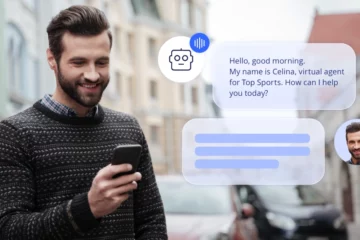There are occasions when there is an imminent need to transition the conversation from a chatbot to a human agent to address complex customer queries. There are other instances where the agent may be completely off the radar, as the chatbot takes care of 100% of all requests. And there are times when a chatbot can support the tasks of human agents. Whatever the case may be, we must ensure that there are seamless processes in place that provide a personalized and consistent customer experience.
Why is it important to have a
frictionless transition?
Frictionless interactions between chatbots and human agents are crucial for delivering high-quality customer service. This is due to several reasons:
- Improved customer experience: with a seamless transition, the customer doesn’t have to repeat the information already provided to the chatbot, saving time and avoiding frustration.
- Greater efficiency in service: allowing the chatbot to handle simpler queries, human agents can focus on more complex questions and provide better service.
- Reduced costs: automating tasks with a chatbot can be more cost-effective than having a team of human agents working 24 hours a day.
- Increased agent satisfaction: by allowing the chatbot to handle repetitive tasks, agents can focus on more challenging and diverse inquiries, which can enhance their job satisfaction.
3 uses of Generative AI to boost Conversational AI. Read more
3 uses of Generative AI to boost Conversational AI.
Read more
How to achieve a smooth
bot-agent transition
To ensure a seamless transition, it is crucial for the customer to know when they are interacting with a chatbot and when they are being transferred to a human agent. One way to achieve this is by giving the chatbot and the agent different names, which can help customers recognize who they are talking to. Another way to facilitate the transition is by allowing customers to request to speak directly with a human agent at any time during the conversation with the chatbot.
It is also important that the assistance bot is integrated with the contact system and the company’s CRM Agents should have access to the chatbot conversation history to seamlessly continue the conversation. This can be achieved, for example, by sending a conversation summary to the human agent when the transfer is initiated, providing them with context about what has already been discussed.
Another way to achieve a smooth bot-agent transition is for the bot to fulfill the role of an assistant quite literally in the interaction. By using predefined responses suggested by the chatbot, agents can select the ideal response and send it to the customer. For example, if the customer mentions your competitor and their lower prices, the chatbot can suggest the products that fall within the mentioned category and the price range that interests the customer.
Step by step guide to
implementing a hybrid ecosystem
Step 1: Define the purpose and objective of your assistant bot
It is crucial to have a clear understanding from the beginning of the role your chatbot will play in your operation. Will it be an assistant working alongside your human agents? Or will it be an independent tool responsible for handling most of the requests? Defining the purpose and goal of the chatbot will help you determine the functions it should have and how it will interact with your customers.
Step 2: Design logical conversational flows
An efficient chatbot must be able to understand and respond to customer questions and requests in a consistent manner. Design logical conversational flows that guide the client to the correct solution and avoid generic or irrelevant responses.
Step 3: Use artificial intelligence technologies
Artificial intelligence technologies, such as natural language processing and machine learning, can significantly improve the bot’s ability to understand human language and provide accurate responses. Investing in these technologies is worthwhile to create a more advanced and efficient chatbot.
Step 4: Integrate transfer options to human agents
AEven if chatbots are capable of handling a wide range of inquiries, there will always be situations where a human agent can provide a better response. Make sure to include options for customers to be transferred to a human agent if the chatbot cannot resolve their query.
Step 5: Test and continuously improve
It is important to test your chatbot before launching it and continue doing so regularly to identify areas for improvement. Listen to customer feedback and make adjustments to your conversational flows and technologies.
Even though not all interactions necessarily need to have a transition, it’s important to have a clear strategy to determine when and how it should be done. Clearly defining the tasks that the chatbot can perform or improve, as well as those that will be handled by human agents, is crucial.
inConcert is a leader in designing contact solutions and artificial intelligence. Contact us to learn more about how we can help improve your customers’ and agents’ experience. Together, we can create exceptional customer service that adapts to your company’s needs.



